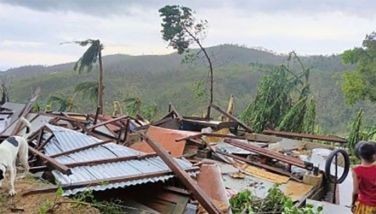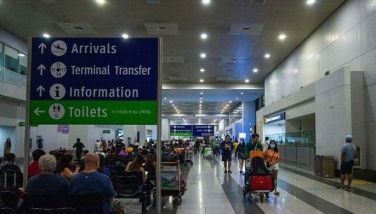‘Poso’ doleouts blamed for ‘sinking’ of N. Ecija
November 6, 2005 | 12:00am
CABANATUAN CITY — If third district Rep. Aurelio Umali has his way, he wants Nueva Ecija politicians to stop giving out shallow and deep wells, which they are wont to do during electoral campaigns.
The reason: the rapid sinking of the province’s groundwater level due to overpumping of wells.
As such, Umali, Lakas-CMD’s provincial chairman, said the propensity of politicians to give out shallow and deep wells to woo voters during elections should stop.
"There is a need for the people of Nueva Ecija not to use shallow and deep wells because they extract groundwater. Once you remove the water from beneath, the tendency is for the soil to dry up and cause the land surface to sink," he said.
"Pag election, puro poso ang ibinibigay (During election time, what are mostly given out are deep and shallow wells)," he said.
In this city, the province’s trade, commercial and education center, the level of groundwater — the source of potable water for residents — has been sinking by at least one meter a year since 1978 because of overpumping, according to a study commissioned by the Cabanatuan City Water District (CCWD).
The CCWD, which operates 17 wells that supply water to 22,000 concessionaires in 56 of the city’s 89 barangays, said the problem is aggravated by the fact that local water demand is expected to increase from 13 million cubic meters at present to 18 million cubic meters in 2025 when the local population is forecast to swell from 241,056 to 334,398.
Across the province, groundwater is also believed obtained for fishponds, plantations and recreational facilities such as golf courses and swimming pools.
Umali said the widespread practice of using deep and shallow wells to extract groundwater is not only hurting Nueva Ecija but also Central Luzon.
He said experts have warned about the problem in a Central Luzon Integrated Water Resource Management Summit in Pampanga recently.
Last July, Dr. Kelvin Rodolfo and Dr. Fernando Siringan, both of the National Institute of Geological Sciences of the Philippines, said areas north of the Manila Bay or the so-called Camanava area (Caloocan, Malabon, Navotas and Valenzuela) as well as Pampanga, Bulacan and Bataan are sinking at rates more than 10 times faster than the rise of oceans because of the excessive use of groundwater.
Subsidence in the northern Manila Bay villages is occurring at a rate of 1.7 to 8.3 centimeters, according to Rodolfo and Siringan.
They cited the findings of an eight-year research entitled "Public governmental reluctance to recognize regional subsidence, a major anthropogenic cause of worsening floods around northern Manila Bay."
The reason: the rapid sinking of the province’s groundwater level due to overpumping of wells.
As such, Umali, Lakas-CMD’s provincial chairman, said the propensity of politicians to give out shallow and deep wells to woo voters during elections should stop.
"There is a need for the people of Nueva Ecija not to use shallow and deep wells because they extract groundwater. Once you remove the water from beneath, the tendency is for the soil to dry up and cause the land surface to sink," he said.
"Pag election, puro poso ang ibinibigay (During election time, what are mostly given out are deep and shallow wells)," he said.
In this city, the province’s trade, commercial and education center, the level of groundwater — the source of potable water for residents — has been sinking by at least one meter a year since 1978 because of overpumping, according to a study commissioned by the Cabanatuan City Water District (CCWD).
The CCWD, which operates 17 wells that supply water to 22,000 concessionaires in 56 of the city’s 89 barangays, said the problem is aggravated by the fact that local water demand is expected to increase from 13 million cubic meters at present to 18 million cubic meters in 2025 when the local population is forecast to swell from 241,056 to 334,398.
Across the province, groundwater is also believed obtained for fishponds, plantations and recreational facilities such as golf courses and swimming pools.
Umali said the widespread practice of using deep and shallow wells to extract groundwater is not only hurting Nueva Ecija but also Central Luzon.
He said experts have warned about the problem in a Central Luzon Integrated Water Resource Management Summit in Pampanga recently.
Last July, Dr. Kelvin Rodolfo and Dr. Fernando Siringan, both of the National Institute of Geological Sciences of the Philippines, said areas north of the Manila Bay or the so-called Camanava area (Caloocan, Malabon, Navotas and Valenzuela) as well as Pampanga, Bulacan and Bataan are sinking at rates more than 10 times faster than the rise of oceans because of the excessive use of groundwater.
Subsidence in the northern Manila Bay villages is occurring at a rate of 1.7 to 8.3 centimeters, according to Rodolfo and Siringan.
They cited the findings of an eight-year research entitled "Public governmental reluctance to recognize regional subsidence, a major anthropogenic cause of worsening floods around northern Manila Bay."
BrandSpace Articles
<
>
- Latest
- Trending
Trending
Latest
Trending
Latest
Recommended




























